Motorhome travel: New Zealand South Island
Words by Helen Werin Photos by Robin Weaver
Hiring a campervan and touring New Zealand's South Island might sound like a distant adventure but it's perhaps easier to achieve than you might think.
Read on for our guide to a campervan adventure on the other side of the world...
Milford Sound
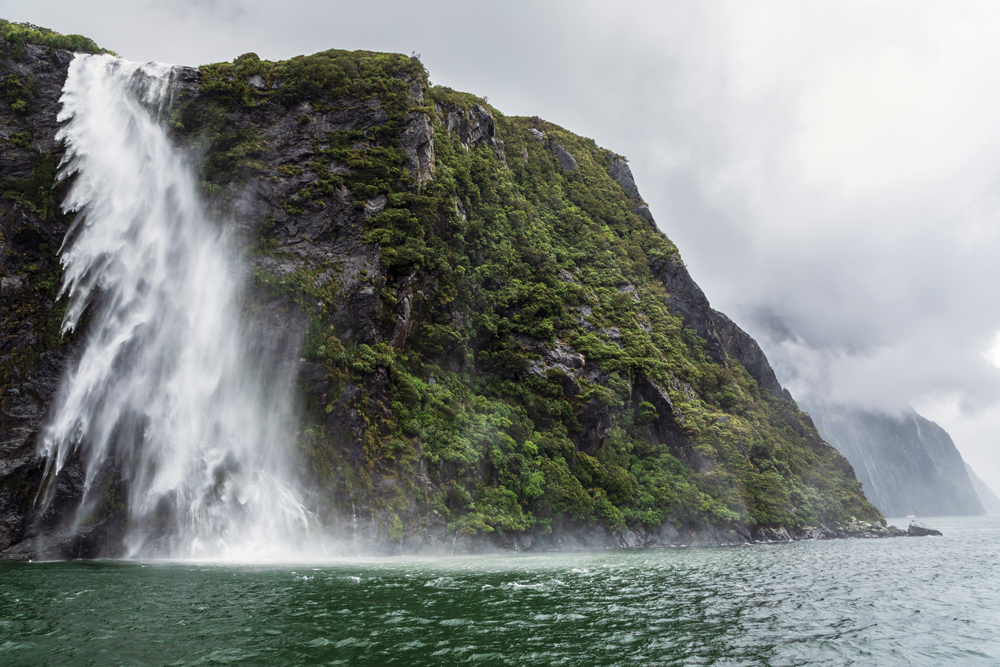
"It’s like entering Jurassic Park,” our campsite neighbours had enthused the night before our trip to Milford Sound. They were right!
Colossal, sheer cliffs – on which Sir Edmund Hillary had honed his skills in preparation for his ascent of Everest – enveloped us either side. Mountains as far as the eye could see astounded us as we emerged from the mineshaft-like Homer Tunnel on our way to the famous fiord.
Thanks to our neighbours we’d been bursting with excitement about what we felt sure would be the highlight of our trip down under – the sound itself and the fantastic journey to reach it.
The bus driver smiled knowingly at the collective ‘wow’ from his passengers. This open-mouthed admiration continued all day, from when we boarded the Cruise Milford boat to navigate between the cliffs and mountains plunging straight down into the water to when we sailed right up to a couple of the falls.
One stupendous cascade splashed the deck, covering it with such tremendous force that it sent those passengers who had dared to brave the power of nature frantically dashing for the door. Yes, waterfalls are everywhere at Milford Sound; the drizzly weather enhanced our experience, creating a soft-focus, dream-like aura.
It was Milford Sound’s notorious amount of rainfall that had forced us to use a minibus to reach there. The Milford Road had only just reopened, to bus convoys only, following a storm that had sent massive boulders down river, flooded properties and left the vast Eglinton Valley under water.
The force of nature in this harsh environment is frightening. I peered out of the window where crash barriers hung over gaps where the road used to be, relieved that we were not driving ourselves.
The extra cost of the minibus was worth every cent, enabling us to soak up our incredible surroundings in a relaxed fashion.
I was doing New Zealand a disservice, totally underestimating its natural wonders, its wild, dramatic and, at times, unnerving, beauty. Many, many more outstandingly memorable moments were to come…
Mount Cook & surrounds
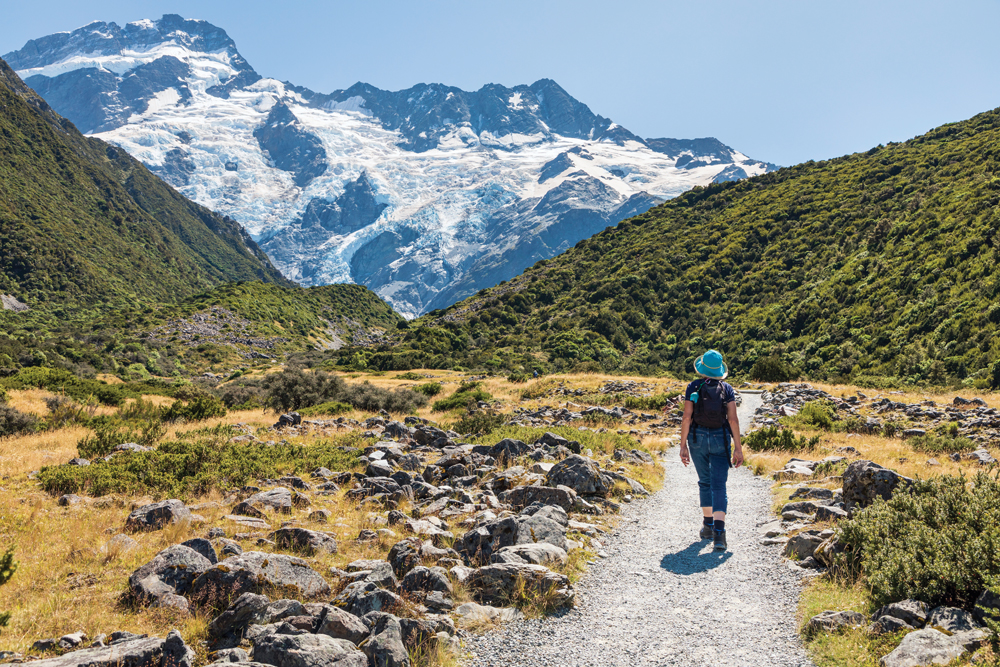
Best of all were some of the wild or ‘freedom’ camping spots. At Lake Pukaki, in the Mackenzie District, we woke to the sight of Mount Cook (3,724m/12,218ft), Australasia’s highest mountain, sneaking its snowy peak out of a drifting cloud. We’d enjoyed dips in the ice-blue glacial-fed water before eating al fresco in the welcome shade of the pinewoods.
Much later, after a glorious sunset, we marvelled at the sight of the upside-down (to us) Orion in the sparkliest sky that I’ve ever seen (Aoraki Mackenzie is an International Dark Sky Reserve). It had been Pukaki’s ‘neighbour’, Lake Tekapo (45 minutes away), which had given us such an awesome welcome earlier as we’d headed towards some of the country’s highest mountains, its mirror-like sheen reflecting the surrounding Southern Alps in cloudy turquoise waters.
Helicopters buzzed low around the craggy mountains as we approached the airfield for Mount Cook. Another Brit whom we met on the road made us very envious of his heli-flight over Mount Cook and swooping low over seemingly bottomless crevasses before landing on the Franz Josef glacier. His warning that he could not walk very far on the glacier because of the danger of these crevasses slightly dissuaded us. Well, that and the huge cost of such a trip!
We were made even more aware of this ever-changing landscape and the creaks of the mountains as we walked the Hooker Valley and Kea Point routes in Aoraki Mount Cook National Park. A sudden roaring noise, unlike any sound I’ve ever heard before, filled the air as huge chunks of snow clinging to Mount Sefton tumbled noisily down the mountainside and an explosion of snow billowed up like smoke. The usually-cheeky keas eluded us (as they did throughout the trip) despite the trail’s name, but our main focus was on Mount Cook, its peak glistening like a beacon in the glare of the afternoon sun.
Lindis Pass-Queenstown
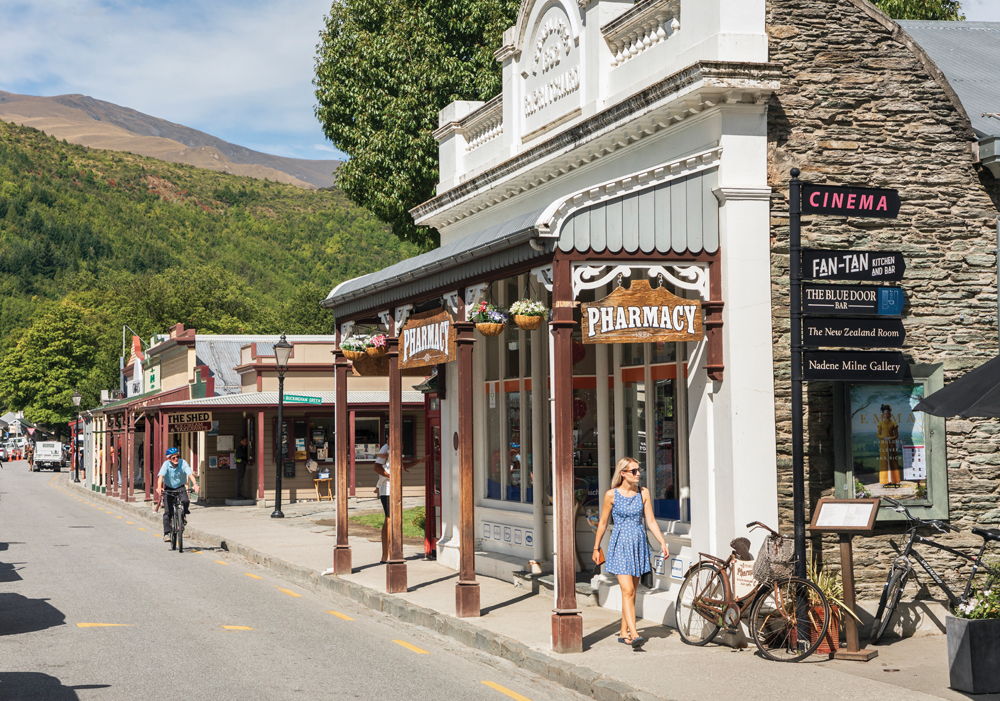
While the icy blues of Pukaki and Tekapo were reminiscent of Swiss lakes, Lindis Pass reminded me of Scotland. Sharp peaks resembled the Dolomites, while hawthorn and beech trees along the Otago Goldfields Heritage Trail hinted at the English countryside. Rust-coloured hills and valleys around Cromwell revealed other delights; ubiquitous roadside shops and stalls selling cherries, apricots, plums and red pears at bargain prices.
The former gold mining town of Arrowtown, between Cromwell and Queenstown, is a coach party magnet, its 1860s wooden buildings transformed into gift shops, fudge emporiums and cafés. It’s very photogenic, but twee tourist hotspots are not for us.
Nearing Queenstown, the town’s ‘adrenaline capital’ status was blatantly apparent as we watched young women bungy-jumping from the old Kawarau bridge, swan-diving confidently in to the gorge and dipping their heads in the foaming water.
We got our thrills for free on numerous walking tracks through dense bush, craning our necks to look up at incredibly tall ferns and red pines.
Queenstown-Haast
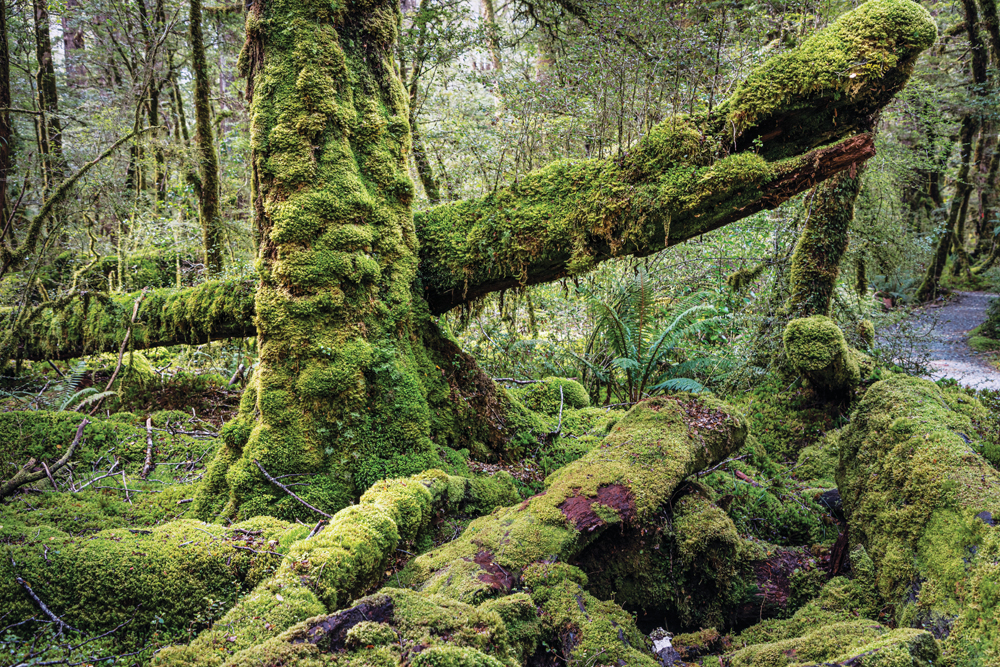 At Cascade Creek nature reserve we stopped to walk among giant beech trees covered in mosses and lichens in ethereal late afternoon light. At Lake Wanaka we ambled around its shores under the gaze of Mount Aspiring before our drive through the Haast Pass, with ridges towering above us on one side and steep, forested valley walls running with waterfalls. A group of young skinny-dippers splashed around at Fantail Falls in joyful celebration of their surroundings.
At Cascade Creek nature reserve we stopped to walk among giant beech trees covered in mosses and lichens in ethereal late afternoon light. At Lake Wanaka we ambled around its shores under the gaze of Mount Aspiring before our drive through the Haast Pass, with ridges towering above us on one side and steep, forested valley walls running with waterfalls. A group of young skinny-dippers splashed around at Fantail Falls in joyful celebration of their surroundings.
Fox Glacier
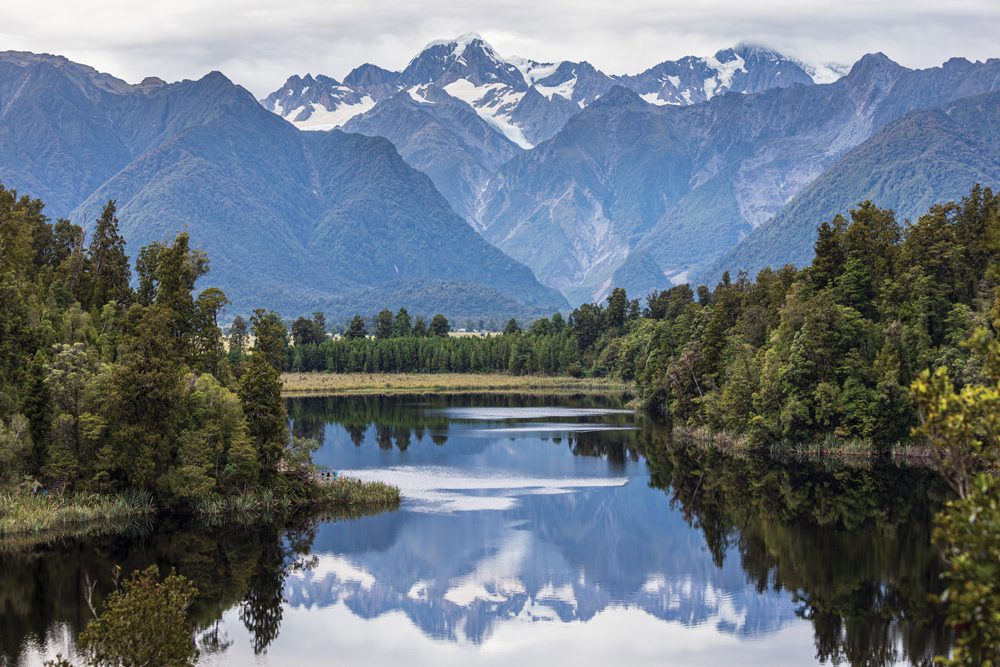 From near our campsite at Fox Glacier township we crept, torches turned off, on to the Minnehaha Walk (¾-mile loop) in search of glow worms. The insects’ lights twinkled all around us, some in large groups like miniature Christmas decorations, others like tiny lone stars.
From near our campsite at Fox Glacier township we crept, torches turned off, on to the Minnehaha Walk (¾-mile loop) in search of glow worms. The insects’ lights twinkled all around us, some in large groups like miniature Christmas decorations, others like tiny lone stars.
The View of Views on Lake Matheson totally lived up to its name, leaving us and other awestruck visitors in a hushed reverence by the effect of Mount Cook, the Fox Glacier and Mount Tasman reflected in its mirror-like stillness. The viewpoint is reached by a pretty 1½-mile round walk through bush and we were reluctant to drag ourselves away from this gorgeous spot. Even with strong memories of how spectacular New Zealand is (I’d lived there as a child) I was constantly surprised at just many more amazing places were to follow…
The Southern Alps have thousands of glaciers, but only the huge tongues of ice of Franz Josef and Fox reach the forest-clad valleys. From a distance, the Franz Josef glacier appeared blue. Later, we trailed in the wake of ant-like figures further ahead walking across the wide and rocky riverbed towards the glacier viewpoint – a one-and-a-half-hour return walk).
Tasman Coast
Along the Tasman Coast the trees have been beaten horizontal by relentlessly strong winds. After Lake Mapourika we wound around alarming landslips, rubble and washed-away trees littering the road.
The Great Coast Road between Greymouth and Westport (classed as one of the top 10 scenic drives in the world) sweeps under rocky walls, gouged with high-sided gorges and above crumbling cliffs on the other, before plunging down to black sand beaches. Mammoth rocks offshore are thick with vegetation.
At Punakaiki, the geological formations created by seismic activity and the pounding of the Tasman are astonishing. Waves have beaten through gaps in the limestone with such ferocity that they have carved out the cliffs behind, creating blowholes from which water explodes magnificently at high tide.
Buttresses of thin slivers of limestone are stacked in towers, hence their name, Pancake Rocks. From a boardwalk wending above the Tasman, we peered in to the holes (whilst wearing waterproofs, of course), awaiting the resounding crash of water and the jets of spray, surrounded by the mighty tiers of ‘pancakes’.
There are several private campervan parks and motorcamps and ‘Yes. Camping!’ signs north of the Pancake Rocks.
One of our biggest regrets was only having time to walk a small part of the 60km (37 mile) Abel Tasman Coastal Track. From Marahau on Sandy Bay, the undulating path through beech forest and across small gullies mostly skirted the coast above granite cliffs, now and then descending to wide, deserted beaches.
Yachts and small water taxis skimmed around islands of all sizes as we strode towards Anchorage Bay and back (25km/15 miles); you can arrange boat transport unless you want to return the same way.
Our big mistake was in driving back to Kaiteriteri via the narrow, tightly twisting Sandy Bay road. I clung to my seat trying not to look over the drops (no barriers in many places!) choosing, instead, to focus on the beautiful deep blue of the Tasman. I’m sure that the occupants of the enviable properties tucked into the bush, with their glorious sea views, didn’t appreciate our warning toot-toots at every bend.
The scenic coastal Rocks Road took us towards Nelson, via the Waimea Plains, where vines and orchards shape the landscapes. At Pelorus Bridge, youngsters leapt off sun-scorched rocks in to the river.
Picton and Wellington
 By now we were high on anticipation of what lay ahead: the Queen Charlotte Drive between Havelock and Picton. Intrigued by the tourist board website’s claims that riding this road is “like cruising the Marlborough Sounds without a boat”, I’d enthusiastically traced it on Google Street View and couldn’t wait to see it for myself. Indeed, South Island had saved some of its best until last.
By now we were high on anticipation of what lay ahead: the Queen Charlotte Drive between Havelock and Picton. Intrigued by the tourist board website’s claims that riding this road is “like cruising the Marlborough Sounds without a boat”, I’d enthusiastically traced it on Google Street View and couldn’t wait to see it for myself. Indeed, South Island had saved some of its best until last.
The Marlborough Sounds, an intricate mass of sunken river valleys, with secluded white-sand beaches fringed by native forest, make up nearly a fifth of the entire New Zealand coastline. Yes, that’s how convoluted this area is. It’s 40km (25 miles) of incessantly windy road to Picton on the Queen Charlotte Drive, every centimetre of it a showcase of outstanding natural beauty. Noisy cicadas buzzed as we joined the Queen Charlotte Track at Anakiwa, hiking through the beech forest to Davies Bay before dropping down to Ngakuta Bay, trying to imprint every gorgeous vista on our memories.
If we hadn’t gone anywhere else in New Zealand but the Marlborough Sounds – and you could spend weeks walking the tracks or kayaking around all the inlets – we would have been fulfilled. Happily, our wonderful adventure that had begun in Christchurch, where we’d rattled along on vintage trams and ridden the gondola to the top of the Port Hills, was to continue across the Cook Strait. North Island had a lot to live up to.
Need to know: New Zealand Motorhome Touring Tips
- Throughout New Zealand, we found it very easy to wild camp or use designated Freedom Camping spots, occasional Department of Conservation sites and local authority overnight places. We weren’t much impressed by the commercial sites.
- Buy sand fly spray for your body; you’ll need it! Their bites itch for days. Maoris used to slap fat and mud on as a repellent
- Carry plenty of bottled water on board; on some basic sites, water can be from a tank, stream or lake
- You are not allowed to park against the flow of traffic
- ‘Responsible camping’ means that you can’t park near homes and must not leave any trace. You can be fined NZ$200 (£97.30) for overnighting where there is a no camping sign
- Roads are generally very good. There are very few laybys on some South Island roads, so take the chance to stretch your legs when you do find one
- Pack warm clothes and rain gear for Fiordland, even if the sun is shining, as weather is extremely changeable
- In South Island, Pak’nSave and Countdown (Woolworths) are cheapest for groceries and have the best selections
- Make a checklist for your hired campervan and tick it off as you check everything before you leave the depot. Some issues may not immediately become apparent so aim to spend your first night within two hours of a depot so that you can return if necessary
New Zealand South Island Campsites
Commercial sites are mostly not to UK club standards; units can be pitched very close together, so don’t expect UK rules about spacing to apply! Facilities can be shabby, though were always clean. Most commercial sites and motorparks have full kitchens with cooking equipment and places to sit, as well as a common room with books, TV and games. There is usually free WiFi and cheap laundry facilities. Be aware that not all commercial sites have toilet and grey waste dumping facilities, even if they have all the other services. Hours are usually 2pm check in, 10am check out.
The DoC (Department of Conservation) has more than 200 sites from serviced to free basic sites. Bookings are required for all serviced sites and for some scenic and standard sites between 1 October and 30 April, otherwise there is a self-registration system at the site or at DoC Visitor Centres.
All the sites listed were ones used on this trip. Unless stated otherwise, they are open all year...
- Winchester Motor Camp, Lot 386, Temuka Orari Highway, Winchester
winchester-motor-camp.business.site - Albert Town Campground, Lake Hawea Road, Wanaka
wanakalakeview.co.nz/alberttown - Fox Glacier Lodge, 41 Sullivan Road, Fox Glacier
foxglacierlodge.com - Omarama Top 10 Holiday Park, 1 Omarama Avenue, Omarama
top10.co.nz/omarama-top-10-holiday-park - Fiordland Great Views Holiday Park, 129 Te Anau-Milford Highway, Te Anau
stayfiordland.co.nz (Open dates vary, contact site) - Motueka Top 10 Holiday Park, 10 Fearon Street, Motueka
motuekatop10.co.nz - Picton Campervan Park, 42 Kent Street, Picton
pictonholidaypark.co.nz
The costs
- Flights Two adults: Economy, Birmingham-Christchurch, Auckland-Birmingham, via Dubai: £2,670
- Campervan hire: (NZ$2,495.95) £1,351.06
- Fuel Average 29mpg: (NZ$326.73) £176.85
- Site fees: (NZ$293) £158.60
- Accommodation fees, Christchurch, two nights: (NZ$174.97) £94.71
Helen Werin is MMM’s Travel Editor and spent a very happy part of her childhood in New Zealand, but this was her first return visit and, hopefully, won’t be her last.
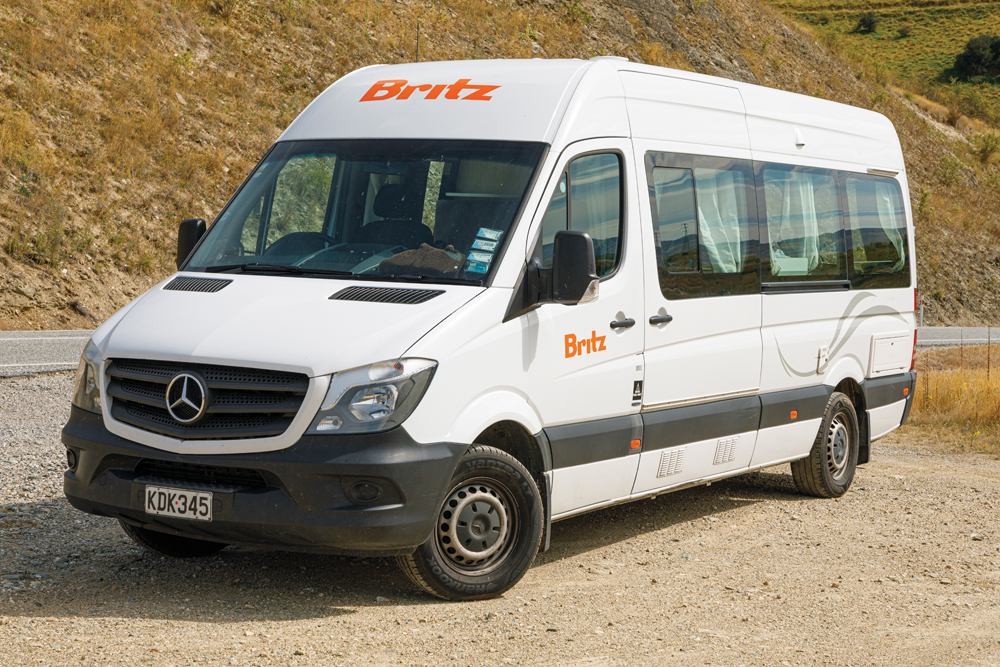 We hired a three-berth Venturer on a Mercedes Sprinter (automatic) hired from Britz. This was a better model than the budget two-berth we’d booked. Handover (and return) was efficient. We liked the campervan, but for a few annoying niggles: the impractical tap over the miniscule washroom sink, totally unreliable water and waste water gauges and the grey water splashing back, very unpleasantly, all over the washroom floor (it could not have been fully emptied by the previous users, as the rules state). We thought we’d checked most things before setting off, but these were problems that only later became apparent.
We hired a three-berth Venturer on a Mercedes Sprinter (automatic) hired from Britz. This was a better model than the budget two-berth we’d booked. Handover (and return) was efficient. We liked the campervan, but for a few annoying niggles: the impractical tap over the miniscule washroom sink, totally unreliable water and waste water gauges and the grey water splashing back, very unpleasantly, all over the washroom floor (it could not have been fully emptied by the previous users, as the rules state). We thought we’d checked most things before setting off, but these were problems that only later became apparent.












Recent Updates
Engine management lights: all you need to know
What is the engine management light? What does it mean, and what do I have to do? ...
Motorhome air suspension: all you need to know
Motorhomes are heavy and the additional weight of equipment and height of the bodywork can increase the loads ...
Motorhome WiFi: how to get better motorhome internet
Staying connected on the move is more and more essential, so relying on campsite WiFi isn't an option – here ...
A class of their own - our guide to A-class motorhomes
Thinking of trading up to an A-class, or even going straight to the top of the motorhome tree? We guide you ...
Explore overseas on a motorhome dream tour
Enjoy exotic travel in a campervan or motorhome by hiring, swapping with someone else or exporting your ...
Motorhome water systems: everything you need to know
On-board water is an important part of every motorhome – here’s everything you need to know ...
Campervanning in Europe: what you need to know
Whether you're planning a leisurely drive through the French countryside, navigating bustling city streets in ...
Campervan security: all you need to know
With thefts on the increase, it’s important to know how to keep your campervan secure and prevent campervan ...
Campervan furniture: everything you need to know
Our campervan experts guide you through all the essentials for your campervan, including tables, chairs, ...
Campervan finance: how to fund your purchase
Here we look at the different types of campervan finance available, to help you decide what’s the best option ...
Other Articles
Britain’s best used motorhomes
Want a great motorhome without paying the premium for a new one? Here's a guide to the best you can get in the pre-owned market for each layout, ...
Which motorhome? Choosing the perfect motorhome for you
Choosing a motorhome or campervan is one of the biggest buying decisions you’ll ever make, so it's important ...
Campervan washroom essentials: stay fresh on the road
Our guide will take you through the campervan washroom essentials you'll need so you're well-prepared for ...
Dogs in campervans: all you need to know
Follow our advice and your dog will enjoy campervanning as much as you do ...
Electric campervans: all you need to know
Our guide will take you through everything you need to know about electric campervans and what the future ...
Motorhome electrics: a complete guide to your motorhome electrical set-up
Motorhome electrics can dramatically enhance the convenience and comfort of your vehicle – but they can be ...
Lighting for campervans: all you need to know
We guide you through all the lighting options available for you and your campervan, including interior ...
Electric bikes for motorhomes: our ultimate guide
Read our comprehensive guide to electric bikes for motorhome owners, helping you add electric power to your ...
Our guide to 'cheap' motorhomes in 2024
If you're on the hunt for an affordable new motorhome, this is the best place to start – we've rounded up a ...
Campervans in winter: all you need to know
Here's your guide to preparing your campervan for the colder months, whether you will be using it or putting ...